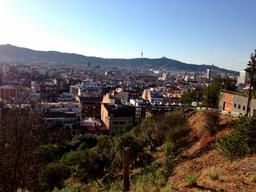el Parc Agrari del Baix Llobregat
- defneapul3
- Jun 13, 2017
- 4 min read

Spain’s unemployment rate is at the lowest since 2010, but it’s still relatively high especially for such a densely populated region. With 18.6% of the population unemployed at the final quarter of 2016, 4.24 million people were without a way to secure living income. Urban agriculture can relieve some of these numbers, while increasing the city’s life satisfaction. However, according to a study on perceptions of urban agriculture in the Mediterranean, (Sanye-Miguel et. al. 2015) people initially began growing food within the city’s concrete boundaries as a primarily social goal to increase healing and happiness among Barcelona’s senior populations. Folks here perceive growing food in the city as a hobby or social activity when grown in the ground. This is both ideologically and physically limited—growing food in the city’s soil, that is. There isn’t much of it.

Barcelona’s landscape from a slightly elevated vista is naught but rooftops. A mosaic of high rises details the city’s uppermost plane (beneath the atmosphere) and in our current day and age, they are unused spaces. Salt Lake City has this great map that highlights all arable land in the city limits—there’s a lot of arable space within the city limits, and a similar same proportion probably exists for rooftops in Barcelona. Green spaces in Barcelona are largely preserved though municipal and other formal And as such, there are only few places where food can be grown in the soil.

Last week, I visited el Parc Agrari del Baix Llobregat, an agricultural preserve maintained just outside of the international airport. Among other products, artichokes, carxofas in Catalan, are grown in the area as had been grown since the beginning of WWI. Various municipalities banded together to create and maintain this Parc as a form of preservation from the high pressure of urban development.
Here, stakeholders from various agriculturally relevant sectors such as academia and government attended the second meeting for PROYECTO MADRE, a formal movement to advance sustainable urban agriculture (UA) in Barcelona. At a previous meeting, the stakeholders brainstormed a few of the most important issues within UA—we discussed four of them (very thankfully translated from Catalan to English by Perla) over the session:
Protect and guarantee water and soil for current and future users.
Increase education and awareness among the general populous for consuming local products.
Foment food sovereignty local agriculture though public policy coordinating with administration, and applying the rules.
Obtain public and political support for urban agriculture methods.

For each of these issues, participants discussed some ideas of how various populations and institutions can achieve each of the four topics. By the end of the session, the major theme was concerning social network development within urban agriculture (can’t get much more topical for me). The parts of the discussion I was able to interpret and that Perla explained to me left a major impression: that more stakeholders need to be involved. For example, only one farmer was present at the previous meeting, and none attended the second. From this standpoint, urban agriculture development is a top-down movement, and I think it needs to seriously engage the workers and entrepreneurs for bottom-up sustainability.

Urban agriculture and urban development should be one in the same in Barcelona, in Salt Lake, in Toledo, and beyond. However, the perception as the two are almost viewed as mutually exclusive. In Barcelona’s case, urban agriculture is not for subsistence, but a form a social therapy—only peri-urban and rural agriculture is perceived as “real” economically viable agriculture. The aforementioned study noted that urban rooftop production has a high potential for intensive, high-yield food production, but socially, architects, government stakeholders, and regular consumers don’t view rooftop farming as possible in the near future. First, because it is not primarily a social activity, and second because it requires a high initial capital investment to establish the infrastructure and supporting policy.
Nonetheless, so did railroads and electricity infrastructure. ICTA researchers and us investigating from Utah and Ohio are working to enliven the conversation about what changes need to be made so urban agriculture is viable for all climate, and cultural contexts globally. There is no one-size-fits-all prescription that can make UA successful for every city, but I’m willing to bet that investment across Barcelona’s rooftops is a gold-medal start. It will certainly create thousands of new jobs, and increase the city’s food sovereignty at least. For example, Perla’s thesis designs and projects the possibility for Barcelona’s hundreds of primary schools dispersed through the area to integrate rooftop greenhouses on each structure and integrate cooking, biology, and other sciences into their curriculum while achieving food sovereignty and increasing health. Education, environmental sustainability and public health are direct befits made possible from thoughtfully applied urban agriculture.

So, I contend that even though rooftop agriculture would be modeled with productivity in mind first, it’s still an inherently social activity. Business-minded folks would invest in urban rooftop farming for two reasons: to produce food, and make money. This requires employable people, skills development, education, human resources. Some new application of governance might arise to ensure the facilities are safe and clean, and that the food is accessible to the residents, workers, and visitors below. That is a future I think we can all get behind!
Fun Fact of the Day: The road we drove through to get to el Parc is known locally as the Road of Cholesterol. Artichokes can help people reduce their cholesterol, so it's joked that doctors send patients to el Parc to get exercise and carxofas for their health!




Comments